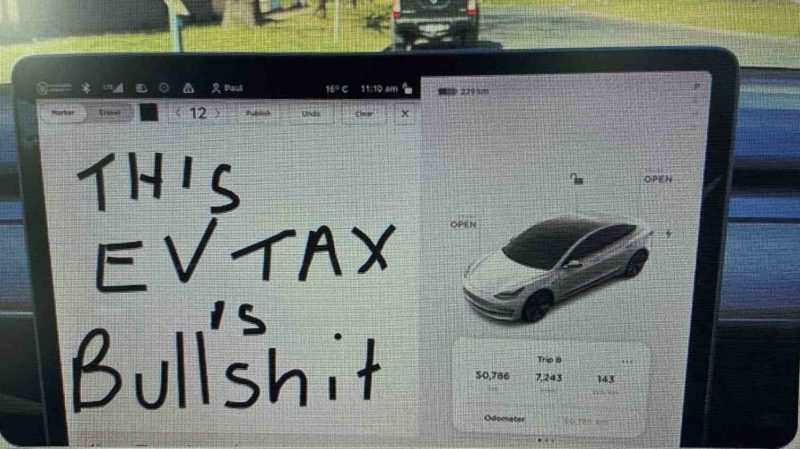It seems like the ‘debate’ about Victoria’s Road Users Charge (RUC) has been portrayed by the Victorian Government as being one of two positions – those in favour of a RUC, and who are painted as fully accepting of the need for it and how it works, and those who complain and are painted as ‘tax dodgers’.
Sadly, it this reminds me of the bad-old-days of the previous federal government targeting benefit recipients for savings through an automated (and flawed) benefit calculation system, whilst characterising recipients and advocacy groups as ‘dole bludgers’ or supporters of them.
That puts me in an awkward position, as I both:
- support a RUC in general terms and its transition to a new form to include electric vehicles (EVs) as the EV Transition itself occurs (after all, we already pay one based on distance travelled through a per litre petrol tax – one that will be lost as fossil fuel sales dwindle) and
- from both personal experience (and reports coming from readers of TheDriven), find the current implementation of the Victorian EV RUC to be a total disaster of an exercise that could have not done a better job of giving RUCs a bad name.
And ‘why?’ you may ask have I come to this conclusion?
First up – as I detailed here, the Victorian EV RUC was rushed through parliament and quickly implemented barely 6 weeks later. As such, it can hardly come as a surprise that its implementation does not seem well thought through.
This certainly has been my experience – as you will read below. It also seems I am not alone! Many TheDriven readers have sent us stories of similar experiences to mine.
So how have I fared?
First up – even getting my first photo registered with VicRoads was hard. It took till December 2021 to be able to personally attend a VicRoads office and lodge the required photo taken on the requested date. (Victorian Covid lockdowns were effectively ongoing throughout that period and VicRoads refused to provide a written form to send in without access to view the vehicle odometer or inspect photo file metadata).
Only an online system to lodge was offered which, for various reasons, was of no use to me.
Amusingly, when I did arrive in person – I was handed a paper form to fill in with ‘car details’, ‘date of odometer reading’, ‘odometer reading’ and ‘signature’.
No odometer photo required. No inspection of the car.
I did, however, hand them a printout of the starting odometer photo and offered an electronic copy of it. Both were politely declined. Why I could not have simply printed and sent that form to VicRoads five months earlier and avoid the potential for Covid infection still baffles me.
Anyway, after all that palaver things seemed normal – until I went in to lodge the end of rego period odometer reading. Again, I had to attend a VicRoads office as still no form was available. Again, I arrived with a printout and electronic copy of the photo – this time for the end date of June 28. (Plus the start date one … in case they had lost it).
I was, by the way, a few weeks late – but within the set period of the letter. (I had been in Perth on the due date, having driven there with my Kona EV – and only returned mid-July).
These photos were done on the correct dates as per the written descriptions on both the VicRoads website and their posted letter. (1.7.21 to 28.6.22 – the date of my Kona’s rego renewal). All covered, or so I thought.
Yet again, I was handed a paper form to fill out first. (“Why can’t I just send this in?” my inner voice asked, yet again).
The staff at the desk said the photos were superfluous, but I insisted they at least keep the printouts anyway. (Nor was any inspection of the car odometer done. (“Why-oh-why do I have to attend in person to just fill in a form?” I ask myself … again).
Things went downhill further from there though.
The poor staff at the counter (two of them by this stage) found the computer system insisted that the first odometer reading was for December 10 2021 and it could not be convinced otherwise – plus it also recorded my second reading for July 20, not June 28 when it was taken. (Having taken it as per the VicRoads letter requesting it to be taken on the rego expiry date and brought in for that date).
As a result, the computer increased my annual distance travelled from 9,923km to 17,164km. Worse still, it came up with a figure of 19 days of that being after July 1 and so was at the new (higher) RUC rate.
Both staff members were very apologetic and went off to their supervisor’s office to sort it out. Ten minutes or so later, they returned saying it was going to take longer than expected and they would issue a corrected invoice once they worked out how to sort the computer issues.
Anyway, to cut a long story short: the promised written invoice arrived in the mail this week. It was however the original error-filled one with no explanation as to why my complaint was being ignored – so still using 17,164 km and pricing some of it at the new tax rate.

One case does not make a systemic failure. Unfortunately, the detail of my experience is eerily similar to other Victorian readers of The Driven.
We now have multiple examples coming in from Victorian EV drivers with reports of buggy computer calculations, inflated RUC invoices and a complete inability by VicRoads staff to override the computer to sort the issues.
It would in fact appear that the computer system simply cannot be overruled by Vicroads staff entering the data and will only use the date of data entry, not the actual dates of the readings.
As for me: I can’t find a way within the VicRoads system to appeal this sort of error beyond my initial verbal querying of the anomalous computer calculations. As a result, I have now been forced to lodge the issue with the Victorian Ombudsman’s office.
Given how overworked that office currently is – I suspect it will be a while before my particular issue is sorted. Hopefully, in the meantime VicRoads don’t follow through with the threat also included in their error-filled invoice – this being to deregister the car in two weeks’ time if it is not paid.
Sadly, we do not have to look far back for a similar example where allegations of false or incorrectly calculated debt notices being issued, refusal to listen to recipients complaints about incorrect calculations along with questions around the lawfulness of the scheme.
Robodebt (the failed, and eventually proved unlawful, Centrelink scheme for calculations and issuing benefit repayment notices) was one of the many negative barnacles attached to the former federal government that eventually brought it down.
If the Victorian government does not do something quickly to either fix the system, or accept it is too poorly developed to implement at this time and suspend it until it is fixed – the analogy to Robodebt (and its eventual messy end) will only grow.
Already, the Victorian RUC is being challenged in the Australian High Court for potentially being unconstitutional – with the pressure increasing recently with the new Federal Government joining in support of the action.
Add to that an ever increasing clamour of complaints and demonstrably idiotic debt notices being issued – well, we all know what happened to the former federal government as Robodebt (and the many other) negative ‘barnacles’ built up on it.
Something perhaps that the Victorian Government should reflect on as it approaches the state election due in November this year?

Bryce Gaton is an expert on electric vehicles and contributor for The Driven and Renew Economy. He has been working in the EV sector since 2008 and is currently working as EV electrical safety trainer/supervisor for the University of Melbourne. He also provides support for the EV Transition to business, government and the public through his EV Transition consultancy EVchoice.

